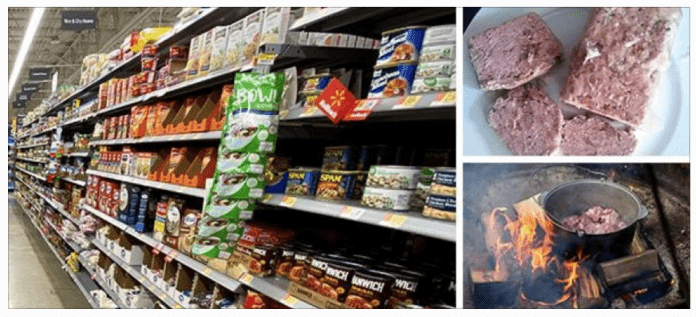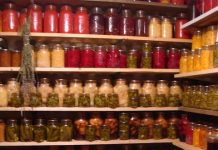How long will the pandemic last?
This question has caused more panic than any other, since the beginning of the outbreak. We have heard everything from 3 months to 2 years.
Our president spat out ’18 months’ at a press conference. Of course, we have no idea what any of that means.
The question people really want to be answered is, ‘how long will it be till things go back to normal.’
No one knows. So, we must prepare and plan to have food for months whether the supermarket has some food or no food. We are preppers.
This is what we do. However, when you start making big plans like adding 6 months of food storage to your plan there are some things to consider.
Preference
I am going to tell you about caloric intake equations, nutritional balance, and foods that store well. Remember, your food storage plan is YOURS and it should be built around preference. One of the things I lean on heavily in my own preparedness plan is oatmeal.
It’s a multipurpose food and a highly nutritious complex carbohydrate breakfast that is great for feeding the body. It can be made delicious with a sprinkle of sugar and cinnamon. If you hate oatmeal than don’t store it!
You and your family should be storing the food you like to eat above all else. This is food storage lesson #1.
When I first started prepping, in 2011, I found tons of blogs telling me about the importance of hard red wheat. Everyone needed buckets of hard red wheat! If you didn’t have it, you were unprepared for the coming collapse.
I had never used hard red wheat before, nor did I have a grinder at the time. I bought a Super pail anyway because I was influenced by fear and by others who proclaimed its necessity.
Mind your preference when it comes to food storage.
Related: 16 Items FEMA Tells You to Stockpile and Why
My Top Food Storage Picks
These food storage items are my preference and I chose most of them because they are multipurpose and provide my family with a variety of nutrients. These are also supplemented by gardening though we calculate for needed calories without the garden.
The garden is a caloric and nutritional bonus.
- Rice
- Beans
- Eggs
- Oatmeal
- Cornmeal
- Flour
- Sugar
- Salt
- Oil
Calculating 6 Months of Food Storage
Let’s start with the basics. We should first calculate how many calories we are going to need, in total, to feed our families for 6 months. That is the most important step in this process. If we are unsure about the total calories needed, we will vastly underprepared because 6 months of food is A LOT!
The RDA is 2000 calories per person per day. Preppers could argue for 2500 to 3000 because of a greater workload in SHTF. Then again, you might want to take a rationing mindset and prepare for 1500 calories per person per day.
Preference
We are going to look at these equations based on a 2000 calorie diet just to keep it easy.
2000 calories per day X the number of people in your home. This will give you your daily caloric needs.
8000 calories per day for a family of 4 X 31 days in a month gives you 248,000 calories per month
For 6 months you are looking at 1,488,000 calories for 6 months if you are feeding a family of four with 2000 calories per day.
Nutritional Balance
Of course, things are a little more complicated than just stacking up calories to the roof. Have you ever heard of rabbit starvation? It can happen to people who don’t get enough fat in their diet from eating very lean rabbits only.
Rabbits are a great protein source, but you need other things to eat alongside them.
Your food storage will need to include things like fats and proteins in the right amounts to assure you have the proper nutritional balance. So, what does that look like? I am going to give you some figures for this nutritional balance. These numbers are for an active person. A sedentary lifestyle will require less.
Protein – A good average for protein intake is going to be around 80 grams. You will need less if you are a small person and as much as 100 grams or more if you are a big active person.
Carbs – The best balance for healthy carb intake is right around 100-150 grams per day. However, in a survival situation you might up that to deal with the rigors or simply to cope with the serious stress of it all. You might also be eating more carbs because that is what you have stored up.
Fats – I often wonder how many people put their bodies through utter hell by cutting all the fat out of their diet in the 90s. Fat is incredibly beneficial to your diet. You want about 400 calories per day from fat. Based on a 2000 calorie per day diet you are going to want around 55 to 80 grams of fat.
A great ration to remember is 30:30:40 and that is 30% fat/30% protein/ 40% carbs. Of course, this will be adjusted if you are dealing with some sort of carb excluding diet. However, for planning and prepping purposes keep this in your back pocket.
Learning to Cook
One of the core skills that all preppers should practice is cooking from scratch. When you look at the list of ingredients above you should be looking at a world of possibilities. You can make all sorts of bread, pastries, tortillas, tostadas and full meals with just those ingredients above.
I see that list as unlimited potential because I spent years making foods with those ingredients. Now is the time for you to become proficient with the mixing bowl and in front of the oven.
We all have at least one complaint about isolation. If you are feeling bored spend some time baking something new. Cook a big pot of beans and see how they turn out. We store a lot of rice and beans but most of America eats beans out of a can.
Tactical training is cool, bushcraft skills get respect but food production and cooking have been the driving force behind all-conquering armies and civilizations throughout all of history.
6 months of long-term food storage is a pretty decent goal for any prepper. It’s very rare that we face a catastrophe that cuts us off the food supply for more than 3 months let alone 6 months. Of course, there is always the threat of that one event that changes the world forever.
Still, in a situation like that, you are eating off food storage while you set up your own inputs for food production. If the whole world goes offline you won’t be sitting around waiting for Walmart to open back up. You will either be hunting, farming, homesteading or some amalgamation.
Since I started prepping there are a handful of preps that truly help me rest at night. Food storage is one of those preps. Having extra food on hand for hard times is one of those things that I would have done even earlier if I knew how good it would feel to have that prong of my preparedness plan sharpened up.





















